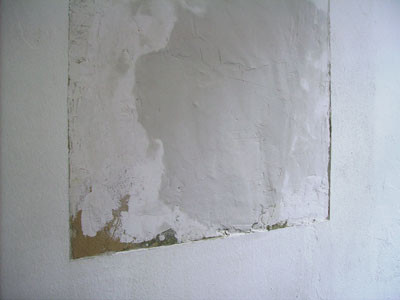Nunc Stans: Frank Berger / Falk Haberkorn
07 Apr - 12 May 2007
Nunc Stans: Frank Berger / Falk Haberkorn
Frank Berger and Falk Haberkorn present their new work in AMERIKA from 04/07 - 05/12/2007.
The everlasting present, the moment of overlapping time compression and concentration as the existential mode of fine art is the focus of this exhibition. The presented works interrogate the time aspect of this term, the relation of fragment and compression and the dimension of the auratic impact.
Falk Haberkorn uses in Nunc Stans a gallery wall for his 'inscriptions' that function as a synthesis of word and image, of sign and signification. In the course of the exhibition Falk Haberkorn will write text on beforehand clearly defined and specially prepared wall sections. Starting from an already visible inscription at the beginning of the exhibition, he will then successively fill the other five surfaces with 'content'. After the inscription work will have been finished, the lasting trace of the scripture (memory) will be erased by painting over it (oblivion) - and will be nevertheless stored under a new layer of paint and mortar.
The tabula rasa of an untouched surface will be ideally overdrawn by an indestructible trace of script. In addition, the comprehensive transcription does not only follow visually but also content-wise a networked structure: passages and quotations of literary and humanistic texts that recur in different modes to issues of memory will be so intertwined and interwoven that - according to the principle of montage, alliance and association - a mental reference space opens up that appears to be infinitely expandable.
The observer is therewith not confronted with immediately comprehensible image objects or can decipher the content at one time. Hence, following the work’s time aspect one is asked to always engage anew with the exhibition space in order to acquire a comprehensive view of the work. Consequently, the moment of involvement with the work must therefore be induced consciously over and over again: the spectator’s concentrated lingering and approach encounters the disposition for constant renewal and discarding on the side of the artist.
Frank Berger juxtaposes Haberkorn‚s work a series of single pictures that are worked in a classical format. However, in looking at the work it becomes quite clear that it does not deal with the concept of a series or the possibility to delineate an inner connection between the respective images. Moreover, every picture claims to stand for itself. The process of depicting is in itself always a process of quiescence of a setting that is transferred into the picture frame by the eye of the artist. As in a doubling of this thought Frank Berger has found such "gestures of fixation" on various thematic and visual levels. His motives appear to be trivial at first, refuse however a simple identification. The extremely concentrated depiction of objects in the picture sharpens the eye for the second level of meaning lying behind the images.
Frank Berger and Falk Haberkorn present their new work in AMERIKA from 04/07 - 05/12/2007.
The everlasting present, the moment of overlapping time compression and concentration as the existential mode of fine art is the focus of this exhibition. The presented works interrogate the time aspect of this term, the relation of fragment and compression and the dimension of the auratic impact.
Falk Haberkorn uses in Nunc Stans a gallery wall for his 'inscriptions' that function as a synthesis of word and image, of sign and signification. In the course of the exhibition Falk Haberkorn will write text on beforehand clearly defined and specially prepared wall sections. Starting from an already visible inscription at the beginning of the exhibition, he will then successively fill the other five surfaces with 'content'. After the inscription work will have been finished, the lasting trace of the scripture (memory) will be erased by painting over it (oblivion) - and will be nevertheless stored under a new layer of paint and mortar.
The tabula rasa of an untouched surface will be ideally overdrawn by an indestructible trace of script. In addition, the comprehensive transcription does not only follow visually but also content-wise a networked structure: passages and quotations of literary and humanistic texts that recur in different modes to issues of memory will be so intertwined and interwoven that - according to the principle of montage, alliance and association - a mental reference space opens up that appears to be infinitely expandable.
The observer is therewith not confronted with immediately comprehensible image objects or can decipher the content at one time. Hence, following the work’s time aspect one is asked to always engage anew with the exhibition space in order to acquire a comprehensive view of the work. Consequently, the moment of involvement with the work must therefore be induced consciously over and over again: the spectator’s concentrated lingering and approach encounters the disposition for constant renewal and discarding on the side of the artist.
Frank Berger juxtaposes Haberkorn‚s work a series of single pictures that are worked in a classical format. However, in looking at the work it becomes quite clear that it does not deal with the concept of a series or the possibility to delineate an inner connection between the respective images. Moreover, every picture claims to stand for itself. The process of depicting is in itself always a process of quiescence of a setting that is transferred into the picture frame by the eye of the artist. As in a doubling of this thought Frank Berger has found such "gestures of fixation" on various thematic and visual levels. His motives appear to be trivial at first, refuse however a simple identification. The extremely concentrated depiction of objects in the picture sharpens the eye for the second level of meaning lying behind the images.

